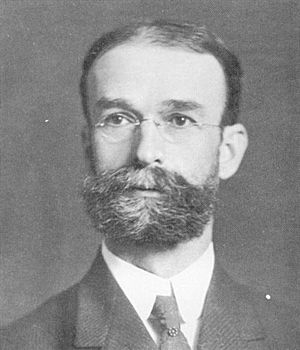Theobald Smith facts for kids
Quick facts for kids
Theobald Smith
|
|
|---|---|
 |
|
| Born | July 31, 1859 |
| Died | December 10, 1934 (aged 75) |
| Nationality | American |
| Alma mater | Cornell University, Albany Medical College |
| Known for | Texas cattle fever, Salmonella |
| Awards | Manson Medal (1932) Copley Medal (1933) |
| Scientific career | |
| Fields | Epidemiology |
| Institutions | US Department of Agriculture, Harvard University, Rockefeller University |
Theobald Smith (born July 31, 1859 – died December 10, 1934) was a very important American scientist. He was a pioneer in studying how diseases spread (an epidemiologist), how tiny germs work (a bacteriologist), and how diseases affect the body (a pathologist). Many people consider him America's first truly important medical research scientist.
Smith's work helped us understand many animal diseases. He studied "Texas cattle fever," which is caused by ticks. He also found a type of bacteria called Salmonella enterica, which is part of the Salmonella family. This bacteria was named after Daniel E. Salmon, who was in charge of the Bureau of Animal Industry.
Smith also studied a body reaction called anaphylaxis. This is a severe allergic reaction. His work was so important that sometimes this reaction is called the "Theobald Smith phenomenon."
One idea Smith had was called the "law of declining virulence." He thought that over time, germs and the animals they infected would become less harmful to each other. This idea was a guess, or a hypothesis, and it turned out not to be true. Scientists now use the "trade-off model," which shows that each disease and host relationship is different.
Smith taught at Columbian University (now George Washington University). He started the first bacteriology department at a medical school in the United States there. Later, he worked at Harvard University and the Rockefeller Institute.
He also helped lead the Carnegie Institution from 1914 until he passed away in 1934.
Contents
Early Life and Education
Theobald Smith was born in Albany, New York. His parents were Philip Smith and Theresa Kexel.
He went to Cornell University and earned a degree in 1881. Then, he studied medicine at Albany Medical College and became a doctor in 1883. After medical school, Smith worked in different temporary jobs, often in medical labs.
In December 1883, he got a new research job. He became a lab assistant with the Veterinary Division of the US Department of Agriculture (USDA) in Washington, D.C.. This was the start of his important research career.
Discovering Diseases
In 1884, Smith became an Inspector for the new Bureau of Animal Industry (BAI). This group was created to fight many animal diseases. These included diseases in pigs, cattle pneumonia, and "Texas cattle fever." Smith worked under Daniel Elmer Salmon, who was the chief of the BAI.
Smith also found the main type of bacteria that would later be called the Salmonella group. For two years, he studied how well vaccines worked in pigs. At first, he thought he had found the cause of hog cholera, but he was mistaken.
Smith then focused on "Texas fever," a serious disease in cattle. In 1889, he and a veterinarian named F.L. Kilbourne made a big discovery. They found that a tiny parasite called Babesia bigemina caused Texas fever. This parasite was carried by ticks.
This was the first time scientists proved that an arthropod (like a tick or insect) could spread an infectious disease. This discovery was very important. It helped scientists later understand that insects can spread many diseases, like yellow fever and malaria.
Teaching and Later Work
From 1886 to 1895, Smith also taught at Columbian University in Washington, D.C. (now George Washington University). He started the school's Department of Bacteriology there. In 1887, Smith began studying water cleanliness in his free time. He looked at how much bacteria from waste was in the nearby Potomac River. Over the next five years, he expanded his studies to include the Hudson River and its smaller rivers.
Smith's work at the BAI was very successful, but he found the government rules too strict. He felt there wasn't enough leadership from his boss. So, in 1895, Smith moved to Cambridge, Massachusetts. He took two jobs: a professor at Harvard University and the director of the pathology lab at the Massachusetts State Board of Health.
In 1915, Smith joined the Rockefeller Institute for Medical Research. He became the Director of the Department of Animal Pathology. He stayed there until he retired in 1929.
In 1933, Smith received a very important award called the Copley Medal from the Royal Society. He earned it for his "original research and observation on diseases of animals and man."
Other Important Discoveries
- He noticed differences between tuberculosis in humans and in cattle (1895).
- He talked about the idea that mosquitoes might spread malaria (1899).
- He studied how bacteria can change and cause disease (1900).
- He discovered anaphylaxis (1903), which is sometimes called "Theobald Smith's phenomenon."
- He worked on Brucellosis infections.
- He used a special vaccine made from toxin and antitoxin to fight diphtheria (1909).
See also
 In Spanish: Theobald Smith para niños
In Spanish: Theobald Smith para niños

